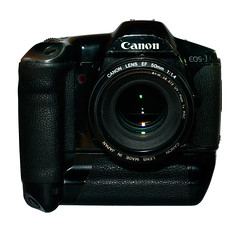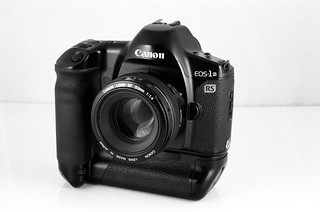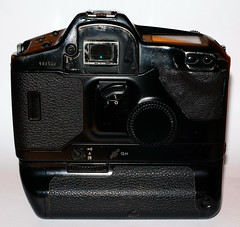Difference between revisions of "Canon EOS-1"
Hanskerensky (talk | contribs) m (→Links: Removed commented out Link URL, page still not present) |
m (→References: Notes, not references) |
||
| (10 intermediate revisions by 3 users not shown) | |||
| Line 1: | Line 1: | ||
| − | |||
{{Flickr_image | {{Flickr_image | ||
|image_source= http://www.flickr.com/photos/wolf-t/9599433565/in/pool-camerawiki/ | |image_source= http://www.flickr.com/photos/wolf-t/9599433565/in/pool-camerawiki/ | ||
| Line 8: | Line 7: | ||
|image_rights= non-commercial | |image_rights= non-commercial | ||
}} | }} | ||
| − | |||
==Description== | ==Description== | ||
Aimed at the professional market, the '''EOS-1''' is notable for being a major game changer for [[Canon]]. For the first time ever, Canon's standard USM lenses offered better focusing performance than [[Nikon|Nikon's]] professional lenses on the then-inferior [[Nikon F4]]. | Aimed at the professional market, the '''EOS-1''' is notable for being a major game changer for [[Canon]]. For the first time ever, Canon's standard USM lenses offered better focusing performance than [[Nikon|Nikon's]] professional lenses on the then-inferior [[Nikon F4]]. | ||
| Line 25: | Line 23: | ||
}} | }} | ||
==EOS-1N== | ==EOS-1N== | ||
| + | {{Flickr_image | ||
| + | |image_source= https://www.flickr.com/photos/endredi/50523119737/in/pool-camerawiki/ | ||
| + | |image= https://live.staticflickr.com/65535/50523119737_5d621d2b07_n.jpg | ||
| + | |image_align= right | ||
| + | |image_text= EOS-1N RS | ||
| + | |image_by= Zoltán Endrédi | ||
| + | |image_rights= with permission | ||
| + | }} | ||
The EOS-1N is an improved version released in 1994. It was sold in combinations called EOS-1N DP which is the body and BP-E1 (LR6/AA) battery pack and the EOS-1N HS is body plus booster which increase the transport speed and can house both (LR6/AA) and 2CR5 batteries. The EOS-1N RS is a pellicle mirror version released in 1995. | The EOS-1N is an improved version released in 1994. It was sold in combinations called EOS-1N DP which is the body and BP-E1 (LR6/AA) battery pack and the EOS-1N HS is body plus booster which increase the transport speed and can house both (LR6/AA) and 2CR5 batteries. The EOS-1N RS is a pellicle mirror version released in 1995. | ||
| + | {{br}} | ||
==EOS-1V== | ==EOS-1V== | ||
| − | The last in the series, the EOS-1v was still in production at least as late as 2010, making it one of the longest production runs for a camera in recent history. According to Canon, they ceased production of their last film cameras, including the EOS-1v sometime prior to January 2011<ref>[ | + | {{Flickr_image |
| + | |image_source= https://www.flickr.com/photos/endredi/50277476767/in/pool-camerawiki/ | ||
| + | |image= https://live.staticflickr.com/65535/50277476767_e820501917_n.jpg | ||
| + | |image_align= right | ||
| + | |image_text= EOS-1V | ||
| + | |image_by= Zoltán Endrédi | ||
| + | |image_rights= with permission | ||
| + | }} | ||
| + | The last in the series, the EOS-1v was still in production at least as late as 2010, making it one of the longest production runs for a camera in recent history. According to Canon, they ceased production of their last film cameras, including the EOS-1v sometime prior to January 2011<ref>[https://www.photo.net/forums/topic/400413-will-eos-1v-be-the-last-film-slr/ Photo.net forum: Will EOS-1v be the last film SLR?]</ref><ref>[http://www.flickr.com/groups/ishootfilm/discuss/72157624721296546/#comment72157624601037383 Flickr ishootfilm forum: Are SLRs still being made?]</ref>, and new stock from the last production run remained available through Canon camera dealers in 2012. Its digital successors include the EOS-1D Mark I-IV, themselves very heavily based on the 1v. | ||
| + | {{br}} | ||
==EOS-1 specs compared== | ==EOS-1 specs compared== | ||
| Line 82: | Line 98: | ||
|} | |} | ||
| − | == | + | ==Notes== |
<references/> | <references/> | ||
== Links == | == Links == | ||
| − | * [ | + | *[https://www.butkus.org/chinon/canon/canon_eos_1/canon_eos_1.htm Canon EOS-1 manual] and [https://www.butkus.org/chinon/canon/canon_eos-1n_rs/canon_eos-1n_rs.htm Canon EOS-1n manual] at [https://www.butkus.org/chinon/ Butkus.org] |
| + | *[https://www.manualslib.com/products/Canon-Eos-1v-181512.html Canon EOS-1v user manual] at [https://www.manualslib.com/ Manualslib] | ||
| + | *[https://global.canon/en/c-museum/product/film132.html Canon EOS-1 page] at the [https://global.canon/en/c-museum/ Canon Camera Museum] | ||
*[http://en.wikipedia.org/wiki/Canon_EOS-1D Wikipedia: EOS-1D] | *[http://en.wikipedia.org/wiki/Canon_EOS-1D Wikipedia: EOS-1D] | ||
*[http://en.wikipedia.org/wiki/Canon_EOS-1n Wikipedia: EOS-1n] | *[http://en.wikipedia.org/wiki/Canon_EOS-1n Wikipedia: EOS-1n] | ||
| Line 95: | Line 113: | ||
[[Category: Japanese 35mm autofocus SLR]] | [[Category: Japanese 35mm autofocus SLR]] | ||
[[Category: Canon EF mount]] | [[Category: Canon EF mount]] | ||
| − | [[Category: Canon]] | + | [[Category: Canon|EOS-1]] |
[[Category: C]] | [[Category: C]] | ||
| − | [[Category: E|EOS | + | [[Category:E|EOS-1 Canon]] |
| − | [[Category: | + | [[Category: 1989]] |
Latest revision as of 00:08, 25 February 2024

|
| EOS-1, EOS-1N EOS-1N RS and EOS-1V image by wolf4max (Image rights) |
Description
Aimed at the professional market, the EOS-1 is notable for being a major game changer for Canon. For the first time ever, Canon's standard USM lenses offered better focusing performance than Nikon's professional lenses on the then-inferior Nikon F4.
The EOS-1 (1989) was succeeded by a few improved models and variations:
- EOS-1n (1994), with improvements in focusing system and various iterative improvements.
- EOS-1n RS (1995), with a pelicle mirror similar to that of the EOS RT and older Pellix.
- EOS-1v (2000), the final version, and the fastest SLR camera with a moving mirror.

|
| EOS-1 image by wolf4max (Image rights) |
EOS-1N

|
| EOS-1N RS image by Zoltán Endrédi (Image rights) |
The EOS-1N is an improved version released in 1994. It was sold in combinations called EOS-1N DP which is the body and BP-E1 (LR6/AA) battery pack and the EOS-1N HS is body plus booster which increase the transport speed and can house both (LR6/AA) and 2CR5 batteries. The EOS-1N RS is a pellicle mirror version released in 1995.
EOS-1V

|
| EOS-1V image by Zoltán Endrédi (Image rights) |
The last in the series, the EOS-1v was still in production at least as late as 2010, making it one of the longest production runs for a camera in recent history. According to Canon, they ceased production of their last film cameras, including the EOS-1v sometime prior to January 2011[1][2], and new stock from the last production run remained available through Canon camera dealers in 2012. Its digital successors include the EOS-1D Mark I-IV, themselves very heavily based on the 1v.
EOS-1 specs compared

|
| back view EOS-1 image by wolf4max (Image rights) |
| EOS-1 | EOS-1N | EOS-1V | |
|---|---|---|---|
| Introduction | 1989 | 1994 | 2000 |
| Shutter speed | 30 sec to 1/8000 of a sec. | ||
| Flash sync | 1/250 sec. | ||
| AF points | 1 | 5 (row) | 45 |
| AF cross sensor | 1 | 7 | |
| Metering range | 1 to 20 EV | 0 to 20 EV | |
| Metering zones | 6 | 16 | 21 |
| Film speed | Auto DX; 25 to 5000 ISO (1/3-step) | ||
| Manual; 6 to 6400 ISO. | |||
| Exposure comp | 1/3 | 1/2 or 1/3 | |
| Mirror lock up | No | Yes | |
| Finder shutter | No | Yes | |
| Motor drive | 2.5 fps | 3 fps | |
| Motor Booster | 5.5 fps | 6 fps | 9 fps |
| Power | 1x 6v lithium 2CR5 | ||
| Size | 161 x 107 x 72 mm | 161 x 121 x 72 mm | |
| Weight | 850g | 855g | 945g |
Notes
Links
- Canon EOS-1 manual and Canon EOS-1n manual at Butkus.org
- Canon EOS-1v user manual at Manualslib
- Canon EOS-1 page at the Canon Camera Museum
- Wikipedia: EOS-1D
- Wikipedia: EOS-1n
- Wikipedia: EOS-1v